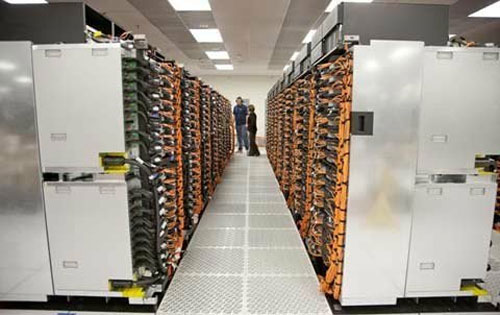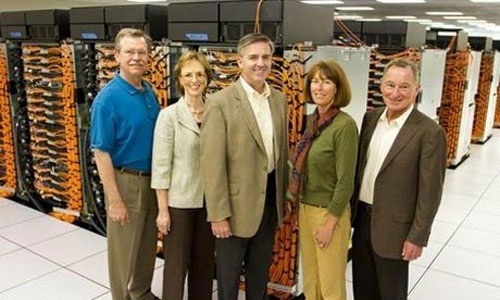Disclosures about supercomputers
You have heard a lot about the word "supercomputer", and right from the name, you can also imagine a part of them: the machines with super-high processing power, but behind what are they? secret?
Mike McCoy - Director of computer programming and high-level simulation at Lawrence Livermore National Laboratory in Livermore, California (also responsible for running Sequoia - the world's most powerful supercomputer in the world) will give We know some interesting information about these super powerful machines.
What is supercomputer?
As the name suggests, it's super powerful computers. Sequoia - IBM's world's most powerful supercomputer, is a collection of many 3rd-generation Blue Gene systems, running on 1.6 million processors. It can reach a processing speed of up to 20 petaflop. A petaflop equals 10 ^ 15 (10 million billion) calculations per second, meaning Sequoia has a calculation speed of 20,300 (20 x 10 ^ 15) calculations per second.

Sequoia - the world's most powerful supercomputer today.
The whole machine needs 3,000 gallons (more than 11,356 cubic meters) of water per minute to cool, averaging 6 to 7 megawatts and sometimes up to 9.5 megawatt electricity, enough for you to imagine maintaining it. How much power does a supercomputer cost (1 megawatt is equivalent to 1 million watts of electricity)."The cost of energy is huge, equivalent to $ 6 million to $ 7 million per year. That's not to mention if we don't work with IBM to optimize, the consumption can be up to 10 megawatts. 1, 6 million processing cores are on 96 different racks, each weighing nearly 5000 pounds and emitting an average of 100 kilowatts of energy, which is enough energy to meet the needs of the 50 households, " McCoy said.
Who is supercomputer for?
Researchers. Every 6 months, Lawrence Livermore National Laboratory receives about 10 researchers to implement projects. Any time there are between one and four projects that must use supercomputers. Stronger machines are prioritized for more important projects.
The concept of researchers themselves is quite large and complex. Their work includes finding ways to simulate the reactions that occur in the sun to modeling physical systems such as aircraft engines, earth climate and human vascular systems.

Supercomputers are only for researchers.
Important policy decisions, in many cases, are often based on the calculations that researchers find, so these results require very high accuracy - a real task. not easy."Imagine you have to work with 1 million PCs every day and they all have to work," McCoy said. If one of these strengths fails, the calculation results may become meaningless.
How much does a super computer cost?
In addition to $ 6 million to $ 7 million in annual energy costs, a "supercomputer" supercomputer ranges from $ 100 million to $ 250 million for design and assembly. That's not to mention the cost of maintaining them.
How much more powerful supercomputers?
Do you wonder why Sequoia needs 1.6 million processing cores? That's because microprocessors are no longer capable . more powerful."The laws of physics have begun to reach the limit," McCoy said. One of the factors that helps microprocessors run faster is to increase their clock speed. However, we cannot increase the pulse at will because the heat that the processor emits can "burn" the supercomputer. If we can't find a way to make microprocessors faster, we simply have to use more chips. That's why the more powerful supercomputers are, the bigger it gets.
But in theory, can a supercomputer with 100 million people be able to process and consume 100 megawatts of electricity? Probably not. That's why researchers hope to have new technologies to help computers achieve 10 ^ 18 calculations per second.
"Life expectancy" of them?
Not too long. In fact, a supercomputer that has a " life cycle " is even lower than an Xbox 360. " Supercomputers usually last only 2 to 2.5 years. Their effects usually last about 5 years. There is no reason to keep these machines due to maintenance costs as well as the costs to ensure their operation is too big.After the "life cycle" is also the time to start building a New computer, "McCoy said.
You should read it
- Supercomputers across Europe were hacked to exploit virtual money
- Compare smartphones and desktops: Why is the phone slower than a computer?
- Cray is about to release AI-based supercomputers
- The difference between quantum computers and supercomputers
- Toshiba's algorithm helps normal computers calculate faster than supercomputers
- Learn to use lesson 6 computer - Mobile devices
 Intel: 'Sleekbook easily confuses customers with ultrabook'
Intel: 'Sleekbook easily confuses customers with ultrabook' About ODM notebook hope in June sublimation
About ODM notebook hope in June sublimation Upgrading Windows 8 Pro takes 40 USD
Upgrading Windows 8 Pro takes 40 USD Satellite P840 photos use Ivy Bridge chips
Satellite P840 photos use Ivy Bridge chips LaVie Z 'lost weight', priced at 1,600 USD in Japan
LaVie Z 'lost weight', priced at 1,600 USD in Japan Ultrabook gradually occupy laptop market share
Ultrabook gradually occupy laptop market share